Abstract
BACKGROUND--A number of studies have suggested that diurnal variation in airways responsiveness underlies the circadian rhythm of ventilatory function in asthma. Measurements of airways responsiveness are therefore often performed at standardised times in order to avoid this possible effect, but this is not practical for epidemiological studies. Refractoriness to methacholine has also been reported and this, too, could confound the results of methacholine tests repeated over short intervals. This investigation was carried out to evaluate the possible magnitude of diurnal variation and refractoriness in repeated measures of airways responsiveness to methacholine. METHODS--To investigate diurnal variation in airways responsiveness, 24 asthmatic subjects aged 18-45 underwent five methacholine tests over three days which were not necessarily consecutive: day 1 at 08:00 hours; day 2 at 08:00 hours, 14:00 hours, 20:00 hours; day 3 at 20:00 hours. To investigate refractoriness a retrospective analysis was undertaken of all paired methacholine tests performed in individuals within our unit between 1984 and 1990 where there had been no intervention likely to affect the results. RESULTS--The first investigation revealed no diurnal change in airways responsiveness although there was a change in FEV1. Mean PD20 did, however, increase 1.57 fold from 08:00 hours on day 1 to 08:00 hours on day 2 for subjects studied on consecutive days. The second investigation confirmed that a test interval of up to 24 hours (but not of 48 or more hours) was associated with a refractory index (PD20 test 2/PD20 test 1) of > 1. CONCLUSIONS--No diurnal variation in airways responsiveness was detected for measurements made between 08:00 hours and 20:00 hours, but an interval between successive tests of up to 24 hours was associated with refractoriness. Diurnal variation is not likely to exert an important confounding effect on methacholine tests carried out between 08:00 hours and 20:00 hours, but confounding could result from refractoriness if tests are repeated at intervals up to 24 hours.
Full text
PDF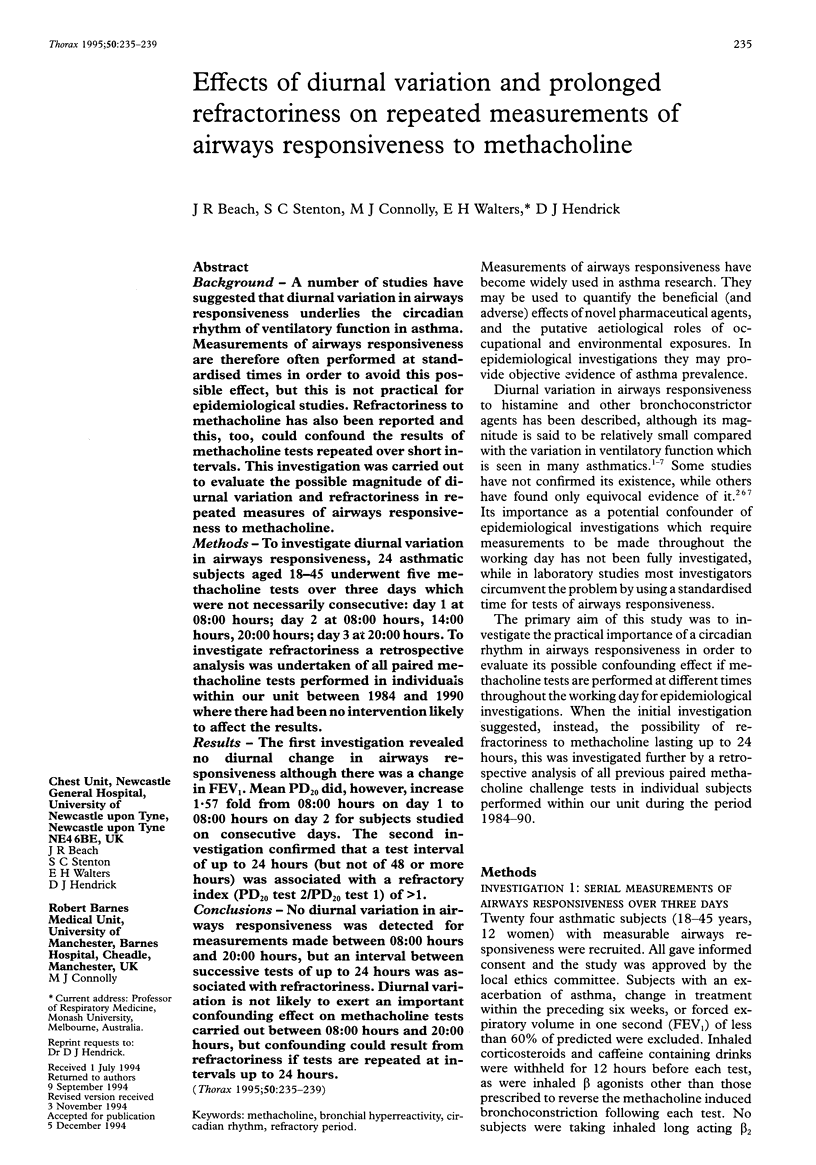
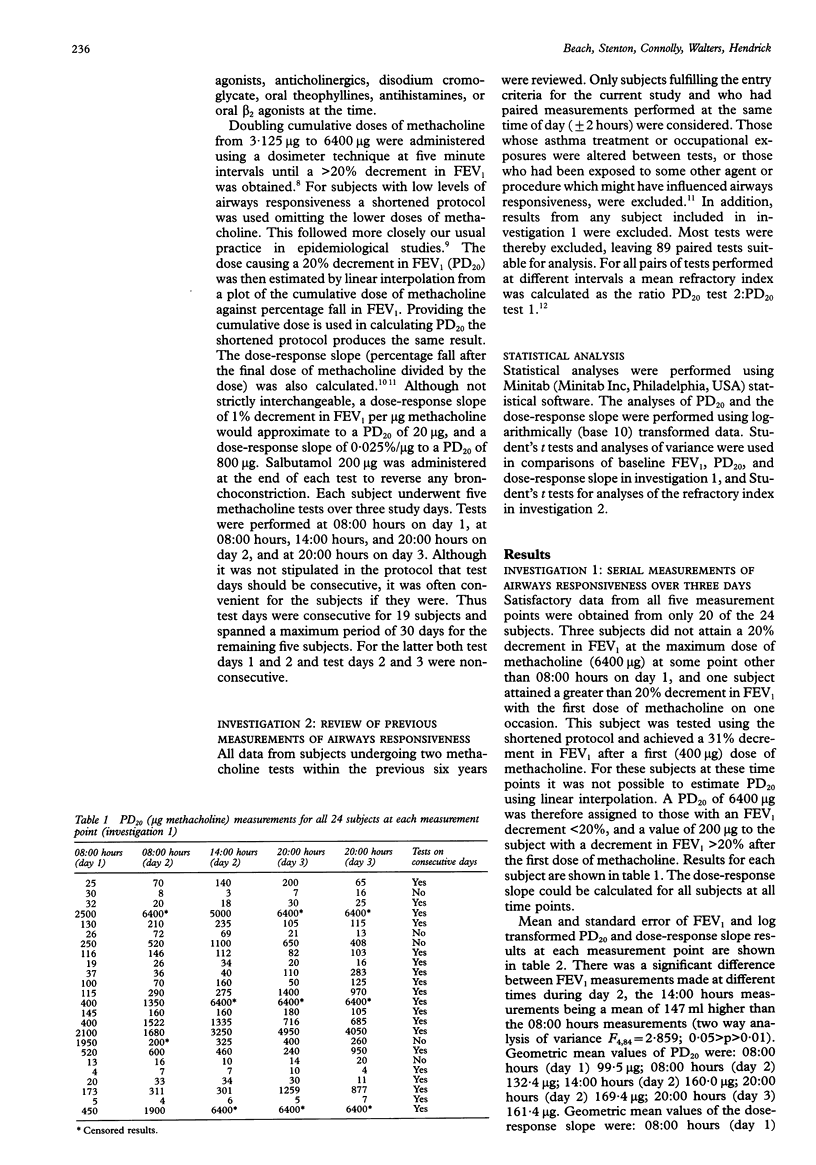
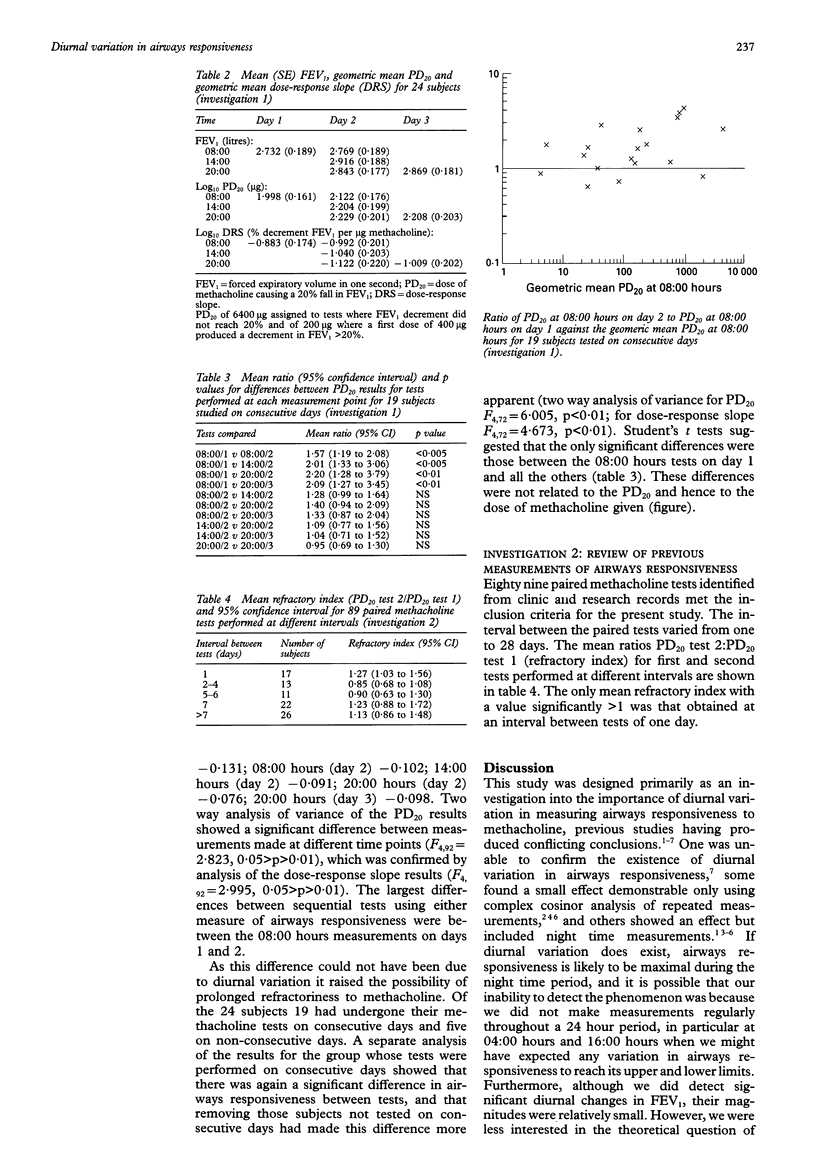
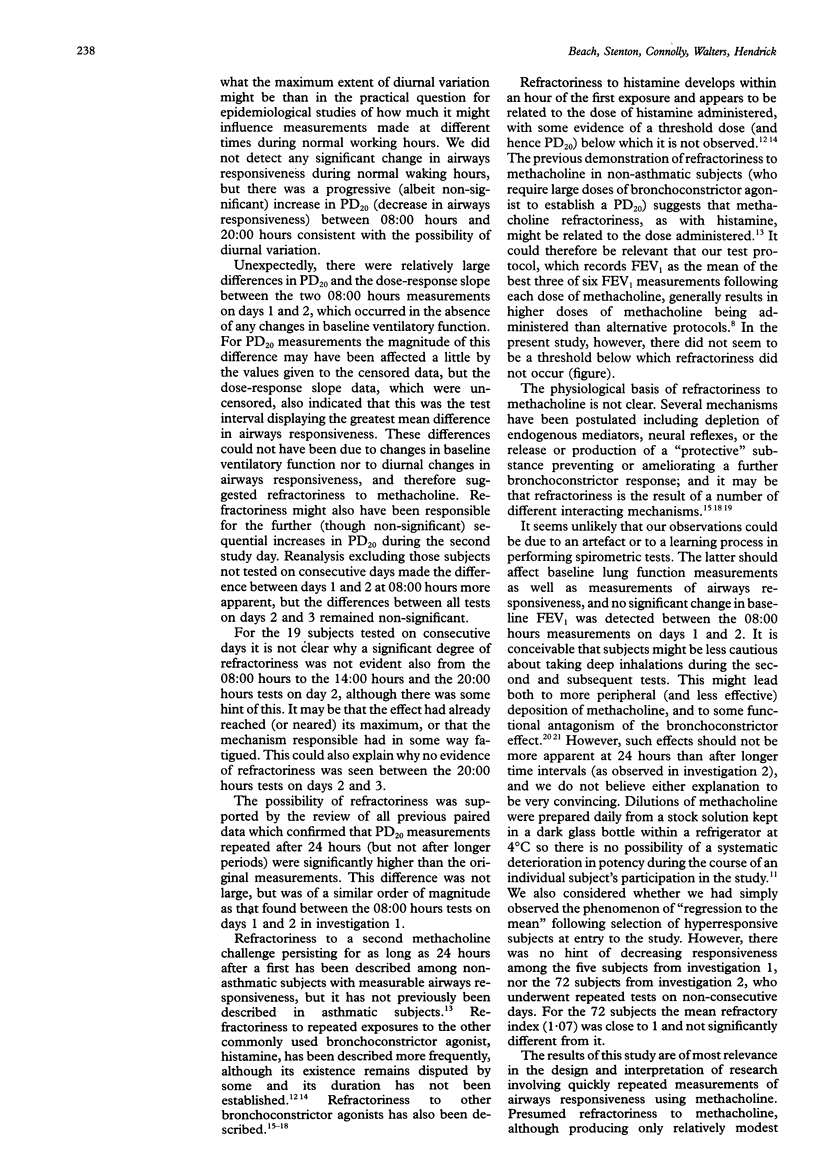
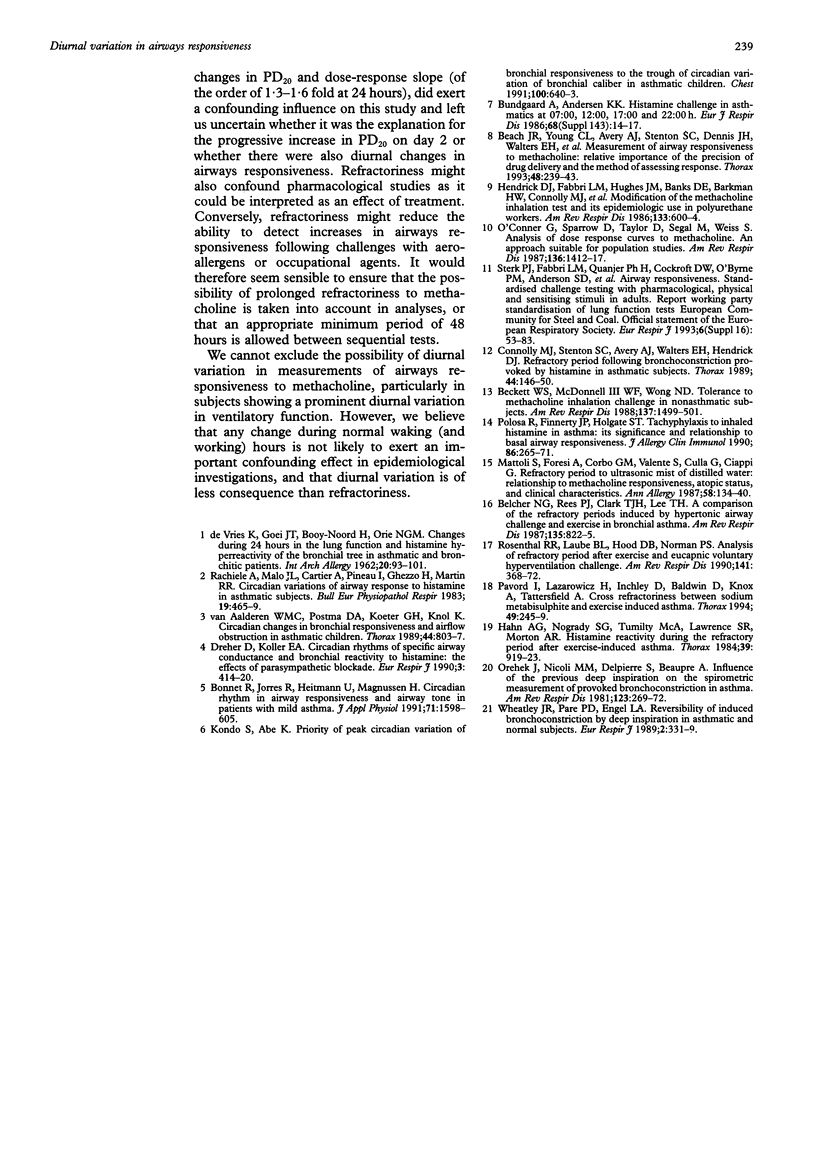
Selected References
These references are in PubMed. This may not be the complete list of references from this article.
- Beach J. R., Young C. L., Avery A. J., Stenton S. C., Dennis J. H., Walters E. H., Hendrick D. J. Measurement of airway responsiveness to methacholine: relative importance of the precision of drug delivery and the method of assessing response. Thorax. 1993 Mar;48(3):239–243. doi: 10.1136/thx.48.3.239. [DOI] [PMC free article] [PubMed] [Google Scholar]
- Beckett W. S., McDonnell W. F., 3rd, Wong N. D. Tolerance to methacholine inhalation challenge in nonasthmatic subjects. Am Rev Respir Dis. 1988 Jun;137(6):1499–1501. doi: 10.1164/ajrccm/137.6.1499. [DOI] [PubMed] [Google Scholar]
- Belcher N. G., Rees P. J., Clark T. J., Lee T. H. A comparison of the refractory periods induced by hypertonic airway challenge and exercise in bronchial asthma. Am Rev Respir Dis. 1987 Apr;135(4):822–825. doi: 10.1164/arrd.1987.135.4.822. [DOI] [PubMed] [Google Scholar]
- Bonnet R., Jörres R., Heitmann U., Magnussen H. Circadian rhythm in airway responsiveness and airway tone in patients with mild asthma. J Appl Physiol (1985) 1991 Oct;71(4):1598–1605. doi: 10.1152/jappl.1991.71.4.1598. [DOI] [PubMed] [Google Scholar]
- Bundgaard A., Andersen K. K. Histamine challenge in asthmatics at 07.00-12.00-17.00 and 22.00 h. Eur J Respir Dis Suppl. 1986;143:14–17. [PubMed] [Google Scholar]
- Connolly M. J., Stenton S. C., Avery A. J., Walters E. H., Hendrick D. J. Refractory period following bronchoconstriction provoked by histamine in asthmatic subjects. Thorax. 1989 Feb;44(2):146–150. doi: 10.1136/thx.44.2.146. [DOI] [PMC free article] [PubMed] [Google Scholar]
- Dreher D., Koller E. A. Circadian rhythms of specific airway conductance and bronchial reactivity to histamine: the effects of parasympathetic blockade. Eur Respir J. 1990 Apr;3(4):414–420. [PubMed] [Google Scholar]
- Hahn A. G., Nogrady S. G., Tumilty D. M., Lawrence S. R., Morton A. R. Histamine reactivity during the refractory period after exercise induced asthma. Thorax. 1984 Dec;39(12):919–923. doi: 10.1136/thx.39.12.919. [DOI] [PMC free article] [PubMed] [Google Scholar]
- Hahn A. G., Nogrady S. G., Tumilty D. M., Lawrence S. R., Morton A. R. Histamine reactivity during the refractory period after exercise induced asthma. Thorax. 1984 Dec;39(12):919–923. doi: 10.1136/thx.39.12.919. [DOI] [PMC free article] [PubMed] [Google Scholar]
- Hendrick D. J., Fabbri L. M., Hughes J. M., Banks D. E., Barkman H. W., Jr, Connolly M. J., Jones R. N., Weill H. Modification of the methacholine inhalation test and its epidemiologic use in polyurethane workers. Am Rev Respir Dis. 1986 Apr;133(4):600–604. doi: 10.1164/arrd.1986.133.4.600. [DOI] [PubMed] [Google Scholar]
- Kondo S., Abe K. Priority of peak circadian variation of bronchial responsiveness to the trough of circadian variation of bronchial caliber in asthmatic children. Chest. 1991 Sep;100(3):640–643. doi: 10.1378/chest.100.3.640. [DOI] [PubMed] [Google Scholar]
- Mattoli S., Foresi A., Corbo G. M., Valente S., Culla G., Toscano L., Bevignani G., Porcarelli M. G., Patalano F., Ciappi G. Refractory period to ultrasonic mist of distilled water: relationship to methacholine responsiveness, atopic status, and clinical characteristics. Ann Allergy. 1987 Feb;58(2):134–140. [PubMed] [Google Scholar]
- O'Connor G., Sparrow D., Taylor D., Segal M., Weiss S. Analysis of dose-response curves to methacholine. An approach suitable for population studies. Am Rev Respir Dis. 1987 Dec;136(6):1412–1417. doi: 10.1164/ajrccm/136.6.1412. [DOI] [PubMed] [Google Scholar]
- Orehek J., Nicoli M. M., Delpierre S., Beaupre A. Influence of the previous deep inspiration on the spirometric measurement of provoked bronchoconstriction in asthma. Am Rev Respir Dis. 1981 Mar;123(3):269–272. doi: 10.1164/arrd.1981.123.3.269. [DOI] [PubMed] [Google Scholar]
- Pavord I., Lazarowicz H., Inchley D., Baldwin D., Knox A., Tattersfield A. Cross refractoriness between sodium metabisulphite and exercise induced asthma. Thorax. 1994 Mar;49(3):245–249. doi: 10.1136/thx.49.3.245. [DOI] [PMC free article] [PubMed] [Google Scholar]
- Polosa R., Finnerty J. P., Holgate S. T. Tachyphylaxis to inhaled histamine in asthma: its significance and relationship to basal airway responsiveness. J Allergy Clin Immunol. 1990 Aug;86(2):265–271. doi: 10.1016/s0091-6749(05)80075-2. [DOI] [PubMed] [Google Scholar]
- Rachiele A., Malo J. L., Cartier A., Pineau L., Ghezzo H., Martin R. R. Circadian variations of airway response to histamine in asthmatic subjects. Bull Eur Physiopathol Respir. 1983 Sep-Oct;19(5):465–469. [PubMed] [Google Scholar]
- Rosenthal R. R., Laube B. L., Hood D. B., Norman P. S. Analysis of refractory period after exercise and eucapnic voluntary hyperventilation challenge. Am Rev Respir Dis. 1990 Feb;141(2):368–372. doi: 10.1164/ajrccm/141.2.368. [DOI] [PubMed] [Google Scholar]
- Sterk P. J., Fabbri L. M., Quanjer P. H., Cockcroft D. W., O'Byrne P. M., Anderson S. D., Juniper E. F., Malo J. L. Airway responsiveness. Standardized challenge testing with pharmacological, physical and sensitizing stimuli in adults. Report Working Party Standardization of Lung Function Tests, European Community for Steel and Coal. Official Statement of the European Respiratory Society. Eur Respir J Suppl. 1993 Mar;16:53–83. [PubMed] [Google Scholar]
- Wheatley J. R., Paré P. D., Engel L. A. Reversibility of induced bronchoconstriction by deep inspiration in asthmatic and normal subjects. Eur Respir J. 1989 Apr;2(4):331–339. [PubMed] [Google Scholar]
- de VRIES, GOEI J. T., BOOY-NOORD H., ORIE N. G. Changes during 24 hours in the lung function and histamine hyperreactivity of the bronchial tree in asthmatic and bronchitic patients. Int Arch Allergy Appl Immunol. 1962;20:93–101. doi: 10.1159/000229248. [DOI] [PubMed] [Google Scholar]
- van Aalderen W. M., Postma D. S., Koëter G. H., Knol K. Circadian change in bronchial responsiveness and airflow obstruction in asthmatic children. Thorax. 1989 Oct;44(10):803–807. doi: 10.1136/thx.44.10.803. [DOI] [PMC free article] [PubMed] [Google Scholar]


